Ladies and Gentlemen, This is MAGI Cinema |
Read more at in70mm.com The 70mm Newsletter |
| Written by: Thomas Hauerslev. Based on material supplied by Douglas Trumbull, Jim Slater, Cinema Technology, and various newspaper and magazine articles. Thanks to Paul Rayton | Date: 01.11.2016 |
 A
bit of a warning for the weak-hearted and die-hard readers of in70mm.com.
This text is about Douglas Trumbull's new digital process called MAGI
Cinema.
A process which may come to rival CINERAMA and Todd-AO where audience participation
and sharp images are concerned. Something that should please CINERAMA and
70mm fans alike. Please try not to get a heart attack when I say, MAGI
Cinema has the potential to
be far better than any 7OMM system we know. A
bit of a warning for the weak-hearted and die-hard readers of in70mm.com.
This text is about Douglas Trumbull's new digital process called MAGI
Cinema.
A process which may come to rival CINERAMA and Todd-AO where audience participation
and sharp images are concerned. Something that should please CINERAMA and
70mm fans alike. Please try not to get a heart attack when I say, MAGI
Cinema has the potential to
be far better than any 7OMM system we know. Please note: I have not yet personally SEEN this system in operation, and what I'm reporting here is based on Mr. Trumbull's assertions, along with reviews and opinions of others. It remains, for me, to be seen (literally and figuratively) if this MAGI lives up to its' promise -- and so I remain open-minded, while we venture into this new era of 'cinematic presentation experiences'... I'm very excited, and we can all hope this lives up to the hype! I still love 70mm film on film, but we must also be open to new developments in this age of technological revolution. Here's how Doug Trumbull explains it:
Under normal circumstances "Billy Lynn’s Long Halftime Walk" would be a film which would get noticed on in70mm.com - provided it was filmed in 65mm or shown in 70mm. In this case, however, the filming and presentation of "Billy Lynn" is completely different from anything seen before in cinemas because it has been produced in something similar (but not the same as) to Douglas Trumbull's innovative High Impact MAGI Cinema digital 4K resolution, 120 frames per second, five times faster than usual, and 3D process. It is the first full length feature film made like this and it opens 11. November 2016. Doug Trumbull has said it almost like this:
See "Billy Lynn’s Long Halftime Walk" in full 120 fps
/ 4k / 3D at these cinemas:
For nearly 90 years, almost every motion picture have been photographed with a speed of 24 frames per second. Every single second of a motion picture have been captured in the cameras with 24 individual pictures. The audience in the cinema have seen the same 24 pictures per second projected on the screen. Every film from "Gone with the Wind" to "Spectre" and 10.000s more, have been photographed like this. That is the way we see the world in the cinema and the standard by which we perceive the texture of "cinema". Doug Trumbull believes MAGI Cinema is the way forward for digital cinema, because MAGI takes full advantage of the capabilities of the digital projectors installed all over the world.
|
More in 70mm reading: • Thoughts about 120 fps / 4K / 3D • Douglas Trumbull - A Conversation • High impact immersive widescreen filmmaking with Douglas Trumbull • A High Impact Experience in 70mm • The Best 70mm I have ever seen • The Future is Now • Showscan Films • "New Magic" in Showscan • The Impact of Showscan PDF: The Brave New World of Cinema by Mark Trompeteler Internet link: "Billy Lynn’s Long Halftime Walk" • hollywoodreporter.com • variety.com • nyt.com • facebook.com • indiewire.com • studiodaily.com • sonypictures.com • nofilmschool.com #1 • nofilmschool.com #2 PDF: Christie RGB Laser Brochure • christiedigital.com YouTube: • "Billy Lynn’s Long Halftime Walk" - Immersive • Pushing the Limits of Cinema |
Douglas Trumbull |
|
 Douglas
Trumbull at work next to a camera at his Trumbull Studios in
Berkshire Hills in Western Massachusetts. Douglas
Trumbull at work next to a camera at his Trumbull Studios in
Berkshire Hills in Western Massachusetts.Douglas Trumbull (b. 1942) is an American film director, special effects supervisor, inventor, innovator, and has been involved with motion pictures since the early 1960s. At the age of 25, he designed and photographed the Star Gate sequence of Stanley Kubrick's "2OO1: A Space Odyssey". Since "2OO1" he has directed "Silent Running", "Brainstom" and Universal Pictures' IMAX special-venue film "Back to the Future: The Ride". He has created visual effects for Steven Spieberg's "Close Encounters of the Third Kind", Ridley Scott's "Blade Runner", Terrence Malick's "The Tree of Life", and the development of the revolutionary high frame rate Showscan process, for which he recieved the Academy's Scientific and Engineering Award in 1993.
Stanley Kubrick wanted to make "2OO1" a
first-person experience. Put the
audience into space. Give them a feeling of being weightless, which is why
he filmed in Super Panavision to get maximum resolution and detail, and had the film
presented on huge curved
CINERAMA screens. Flat screen does not work at all if you want to involve
the audience. Young Douglas Trumbull was intrigued by this idea of audience
participation and Stanley's vision. Stanley Kubrick was frustrated by the
limitations of 24 frames pr second, as it ruined the illusion of space, when
the stars would flicker if the cameras went by too fast. Doug Trumbull became
interested in fast frame rates during the making of "2OO1" when he
noticed some extremely odd things, when he was working on the editing
machines. The machines could go very fast forward and in reverse with a much
higher frame rate than the standard 24. The image changed, but he didn't
investigate it until 10 years later by the mid '70s. |
MAGI Cinema • theasc.com • rogerebert.com • hollywoodreporter.com • technologyreview.com • blooloop.com • bostonglobe.com • berkshireeagle.com YouTube: • UFOTOG Trailer • Magi Cinema Presentastion • Trumbull interview #1 • Trumbull Interview #2 PDF: Press release: UFOTOG, an experimental sci-fi adventure in MAGI Trumbull Studios 227 New Marlboro-Southfield Road New Marlborough MA 01230 USA 42.111639, -73.238078 |
The Magi Cinema Experience |
|
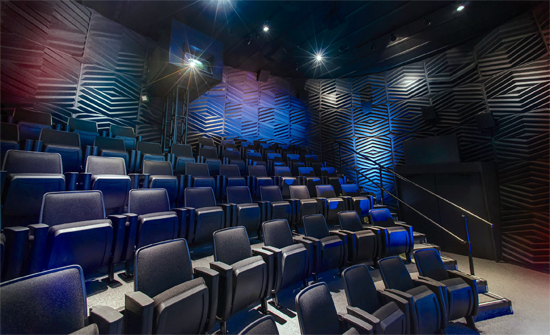 The Magi process is also compatible with Premium Large Format theaters,
whether or not they have the latest 4K HFR and HDR capable dual laser
projection systems such as those being offered by Christie, Dolby, Barco,
and others. The Magi process is also compatible with Premium Large Format theaters,
whether or not they have the latest 4K HFR and HDR capable dual laser
projection systems such as those being offered by Christie, Dolby, Barco,
and others.Since the late 1920's, when sound was introduced on film, film speed has been set at 24 frames pr second in motion pictures and it has not changed since. That was OK in 1927, and the absolute minimum with which sound could be played without too much distortion. Below 22 fps, flicker and strobing are introduced, especially in bright scenes. To smooth out this unwanted effect, the film projector is showing each frame twice, giving the audience a pseudo impression of 48 frames pr. second. When fast action is photographed, a lot of motion blur is also introduced with loss of detail, and the illusion of reality is completely lost. This is particular bothersome in 3D, as it causes eyestrain. "3D is simply not very good", he says. All digital projectors are aligned for the ANSI/SMPTE standard of 16 Ffl +/-2 and are only half as bright as MAGI. In 3D it is even worse, since filters in the projector takes about half the light, and then again the glasses takes another half, leaving only 3 to 4 foot lamberts of light to the audience. Apart from film speed, almost every other aspect of film has been improved the past 90 years. When the exhibition industry jumped to digital, film speed remained the same. With the introduction of digital cinema, quality was generally lowered compared to 35mm film. Agreed, presentation looks very good in 2k. There are no scratches, no jump or weave, splices, broken or scratched films etc. But the 2k quality is much lower compared to old fashioned 35mm film, let alone 70mm quality. There was one advantage of digital projectors, however: In 2009 Doug Trumbull realised that almost all modern digital projectors run at 144 frames pr. second by default. Unlike 35mm film, digital projectors flashes each film frame 5-6 times. Doug Trumbull decided to investigate if this technology could be used for a more immersive cinema experience. "We can now do Showscan without the limitations we used to have, and at twice the speed!". Doug Trumbull decided to go for 120 frames pr. second and a very bright screen, twice the speed of Showscan, to create a totally different sensation for the audience. Doug Trumbull was stunned at the result when he saw their first test footage. The screen went away entirely, and the 3D was perfect and all the problems of normal 3D were eliminated with the high frame rate, increased resolution and a very bright screen.
|
|
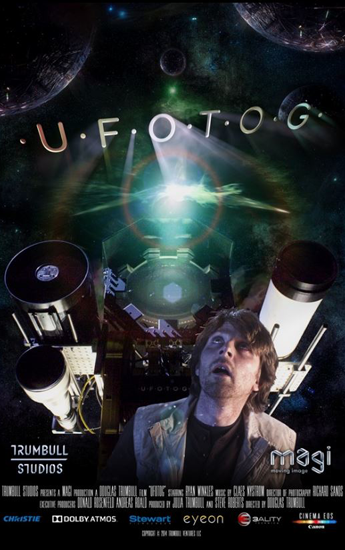 "UFOTOG"
demo film demonstrates what the
Magi process is all about. Digital photographic and projection technology that
can be used in new or existing theaters. Conventionally
configured theaters, regardless of seat number or screen size, do not offer
an experience that compares to the MAGI Pod. "UFOTOG"
demo film demonstrates what the
Magi process is all about. Digital photographic and projection technology that
can be used in new or existing theaters. Conventionally
configured theaters, regardless of seat number or screen size, do not offer
an experience that compares to the MAGI Pod.He made a 10 minute short film in MAGI called "UFOTOG", which demonstrates all that can be done with high frame rate, 4K resolution, a very bright screen and 3D. The response has been overwhelming, and several of Hollywood's directors and producers have already found their way to New Marlborough to see what Doug Trumbull is working on. "My main objective, is to show to the industry what is possible to do with MAGI", he says. "MAGI isn't for all films, like 3D isn't for all films, however, if you have a story that requires the audience to get a feeling of participation, MAGI's hyper-reality is the way forward". The 3D is exceptional, almost to the point of perfect, and many say it is the best they have ever seen. At 120 fps, blur is completely gone. "Blur makes it difficult for our visual systems to fuse the images, which can cause eyestrain", according to Tim J. Smith, a visual scientist at Birkbeck, University of London. It has always been Doug Trumbull's personal ambition to involve the audience much more in the action on the screen. He wants to enhance cinema going and involve the viewer in the action. He, like his mentor Kubrick before him, wants it to be a first person experience. Audience participation is the ultimate goal for any film maker. Doug Trumbull developed MAGI for this purpose, and he feels this is something the motion picture production and exhibition industry must consider to implement to survive. The cinemas are not selling enough tickets for various reasons. The industry has to think beyond 24 frames pr second and reinvent exhibition. The audience is going away, cinemas are suffering and they mostly make their money on popcorn and Coca Cola. The audience can get high quality pictures and entertainment almost anywhere. 4K streaming is available over the internet directly to peoples homes. In 2020 the Olympics from Tokyo will be broadcast in 8K! There is every reason the industry should try to add something new to the palette of tools. MAGI Cinema offers a new level of digital cinema, and new possibilities with 120 fps. It is bigger, brighter, clearer and with greater depth-of-field than anything ever seen in a cinema before. The almost hyper-real image quality of MAGI Cinema's 120 fps, 3D and 4K resolution also ensures it is NOT something the audience can get at home - yet! MAGI is an immersive experience they can only get in cinemas. |
|
The Magi Pod |
|
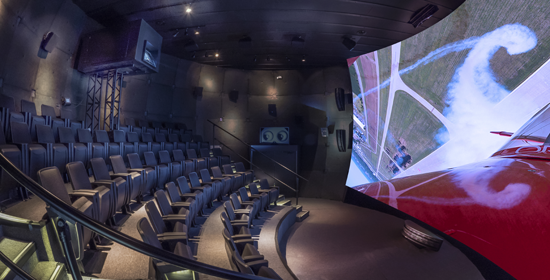 The
MAGI Pod demo cinema located at the Trumbull Studios with Christie's
Mirage 4KLH projectors which delivers 65 fl on the screen. 60 seats, a
curved MAGI screen, and curved seating. The
MAGI Pod demo cinema located at the Trumbull Studios with Christie's
Mirage 4KLH projectors which delivers 65 fl on the screen. 60 seats, a
curved MAGI screen, and curved seating.To get the full advantage of MAGI, Doug Trumbull is proposing to build a new kind of cinema called the MAGI Pod. A relatively small high-impact mini cinema with 60 seats, a 11 x 5 m curved MAGI screen, and curved seating to ensure everyone is looking at the center of the screen. The screen is curved to reflect three times as much light to the audience. It is a new kind of cinema optimized for the MAGI experience with a field of view lager than most cinemas have today. The MAGI Pod can be prefabricated and sent to the cinemas, and set up in a week. It's almost Showscan specs, with a wide wall-to-wall and floor-to-ceiling curved screen, 32-channels of Dolby Atmos surround sound, stadium seating, but with the added advantage of a 4K high-resolution projector.
Ideally "Billy Lynn’s Long Halftime
Walk" will be presented in some MAGI Pod cinemas, with
Christie's Mirage 4KLH projectors which delivers 65 fl on the screen, with
28 fl behind Dolby's 3D glasses, but those projectors are not available yet,
except for the trade shows and festival screenings so far. And there is only
one prototype MAGI Pod cinema, and it's located at the Trumbull Studios. It is expected
that only very few conventional cinemas will show “Billy Lynn” entirely as intended by the film
makers.
|
Sony is planning to
release Billy Lynn in three preferred formats - all
in SMPTE-DCP (Type A): • 3D60-2K (250Mb/s) • 2D60-2K (250Mb/s) • 2D120-2K (250Mb/s) isdcf.com |
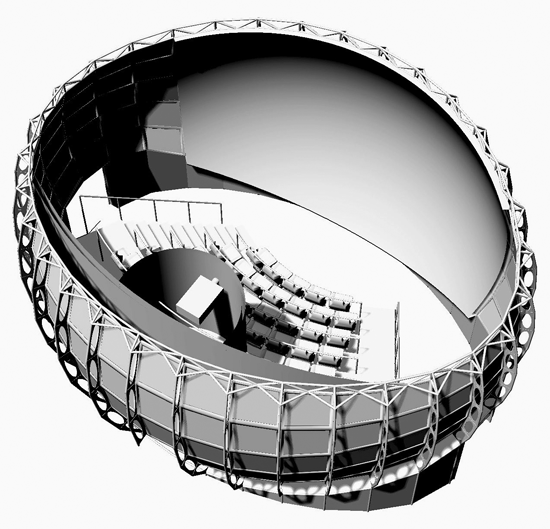 The
Magi screen is much wider and more deeply curved. Every seat faces the
screen, in steeply raked stadium style, with no distortion, no bright or dim
spots, and no uncomfortable viewing angles. The sound system and acoustics
are unique as well – offering sound quality and low frequencies that do not
exist anywhere else. The
Magi screen is much wider and more deeply curved. Every seat faces the
screen, in steeply raked stadium style, with no distortion, no bright or dim
spots, and no uncomfortable viewing angles. The sound system and acoustics
are unique as well – offering sound quality and low frequencies that do not
exist anywhere else.• Patented single projector process delivering 4K 3D at 120 fps • 5x frame rate, 4x resolution, 4x brighter, 4x larger field of view • Less expensive per seat than any other Premium Large Format (PLF) offering • Unprecedented 3x gain hemispherically curved “torus” screen offers very wide 3D • Thundering 32 channel surround sound with frequency response of 1 Hz - 20 kHz Douglas Trumbull feels the weak link is exhibition and that presentation of films can be improved a lot. He wanted to make the audience feel they are entering the holo-deck of Star Trek, or a time machine when they go in to see a film produced in MAGI. He tried to make the theatre itself an object of interest, unlike modern multiplexes, which he feels are boring. He had to design a new theatre built of modular pre-fabricated elements. A complete theatre, with incredible Dolby Atmos sound system and acoustics. It's an oval object, and looks like an easter egg with a deeply curved high gain screen, great sight lines, and curved stadium seating. It's unlike any theatre you have ever been in. It's not rectangular, it does not have flat walls or a flat screen. The MAGI Pod arrives in your multiplex in a 40" container, like a mobile home, when a crew of 5-6 men assemble it in a week, and then you are up and running with this completely new cinematic experience. The MAGI Pod is not only an idea for cinemas, but also for an almost unlimited number of theme parks, zoos, planetariums, cruise ships, universities, museums, etc. It can go in anywhere. The only prototype and demo theatre yet built is at Trumbull Studios in Berkshire Hills in Western Massachusetts. |
|
Reviews |
|
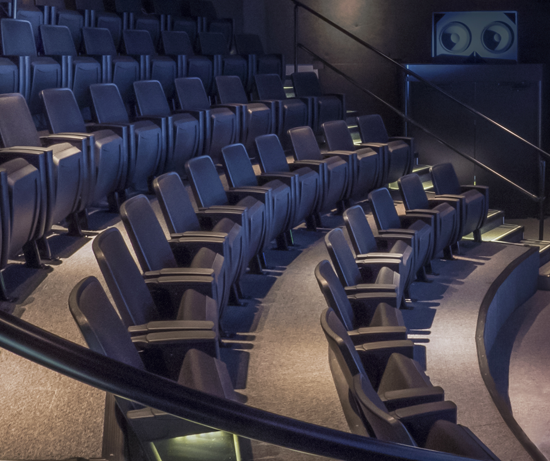 ".......(I) was astonished to be completely
‘blown away’ by the clip from Billy Lynn. Without any doubt at all these
were the best 3D cinema images I have ever seen - sharp, clear, with
enormous depth of field when appropriate - yes, in many ways it was like
looking out of a window onto a very bright outdoor scene." ".......(I) was astonished to be completely
‘blown away’ by the clip from Billy Lynn. Without any doubt at all these
were the best 3D cinema images I have ever seen - sharp, clear, with
enormous depth of field when appropriate - yes, in many ways it was like
looking out of a window onto a very bright outdoor scene."Jim Slater, Cinema Technology "It was an overwhelmingly realistic and intimate, immersive, first-person experience" Martin Howe, blooloop.com "... the images in “Billy Lynn” have an astonishing clarity and physical presence". Variety's review 14.10.2016 "When I left this incredible experience at NAB, I was trembling and terrified, as though I was actually in that experience. We saw the future, and I am enormously grateful that Ang Lee made this happen for us all" Bill Desowitz, indiewire.com |
|
High Expectations |
|
|
I am a big fan of high frame rate and the experience of how realistic things get, when the frame rate goes up. I have seen both Todd-AO at 30 fps, Cinerama at 26 fps, and the best of all, 70mm Showscan projected at a staggering 60 frames pr. second. Showscan is by far the best, most realistic, and most impressive motion picture system I have ever seen. Unfortunately it did not go anywhere with dramatic films. My memory of 60 fps has stayed with me for 25 years and I recently became excited when I saw the news about Mr. Lee's new film photographed at 120 fps. 120 fps will ensure more detail and brightness - something I miss in 3D, which I why I almost never see 3D. It's too dark with current technology, and doesn't add anything to the cinema experience for me. MAGI Cinema sets new standards for the movie makers, they have to unlearn all they know, and go boldly into new territories. Actors must learn new ways to act, set decoration must be much better, cinematographers must learn how to shoot dramas at 120 fps. etc, etc. Cinema audience must appreciate this as something all new and embrace it as a new form of entertainment, which is very different from ordinary cinema.
Being a former projectionist, the immersive
experience and picture quality on the curved screen has always been my
interest. For me 7OMM film has always been the best, and it has thrilled me
for nearly 40 years. Now it seems, there is something that can match it, and
maybe even do it better. My feeling is that MAGI Cinema is a totally new
concept of movie going, so unlike anything we have seen previously. It is a
look into what is possible with audience participation and technology. I
certainly welcome "movies without filter". MAGI is not cinema as I
know it. It's a new experience which sounds
far better, because at 120 fps, everything is suddenly visible.
The 4th wall disappears and you are fooled to believe what you see is real.
Exactly like when a theatre curtain goes up in a live theatre and you see
the stage and actors. The scene is real and you understand that. MAGI Cinema
is like looking at the real world, only this is an illusion of reality,
where the illusion seems entirely real. I am very exited by this, and
I can't wait to see it. Doug Trumbull's MAGI Cinema endeavour reminds me a
little bit about Fred Waller who envisioned CINERAMA, and Mike Todd who
envisioned Todd-AO 60+ years ago, and they both changed the way we see
films. This is 21st century and like Lowell Thomas once introduced CINERAMA,
someone ought to say "LADIES AND GENTLEMEN, THIS IS MAGI CINEMA!" |
|
| Go: back - top - back issues - news index Updated 22-01-25 |
